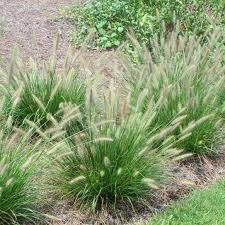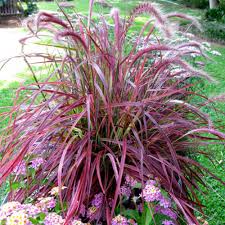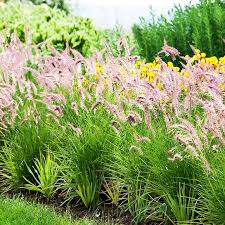Fountain grass, also known as Pennisetum setaceum, is a pretty plant that can make your garden or yard look really nice. It comes from Africa and has long, thin leaves that can be green or reddish. The best part is its fluffy flower parts that look like brushes. These show up in late summer and stay until fall, moving with the wind and making your yard more interesting.
One great thing about fountain grass is that it can grow in many kinds of soil and doesn’t need a lot of water once it’s grown. You can put it in different parts of your yard – in the middle, near the edges, or even in pots. Taking care of it is easy. Just trim the dead parts sometimes and the old flowers to help new ones grow. If you see the plant getting too big, you can split it into smaller parts.
Fountain grass doesn’t just look nice, it also helps birds and bugs by giving them food and places to hide. But be careful, in some places, it might spread too much and not be good for the environment. So, before you plant it, make sure it’s okay for your area.
In short, fountain grass (Pennisetum setaceum) makes your yard look beautiful. It has special flowers, is easy to take care of, and helps nature too. Whether it’s gently moving in the wind or standing tall, this grass can make your yard look amazing.
Read Also: Everything You Need To Know About Dethatching Lawn
Growing and Care Guide of Fountain Grass

Fountain grass, also known as Pennisetum setaceum, is a wonderful plant to have in your garden. It’s not difficult to grow, and with a little care, it can really thrive. Here’s a simple guide to help you grow and take care of fountain grass:
1. Planting:
Choose a sunny spot: Fountain grass loves sunlight, so pick a place in your garden that gets at least 6 hours of sunlight each day.
Soil preparation: Make sure the soil is well-draining. You can add some compost or organic matter to improve the soil’s quality.
Planting time: Spring or early summer is the best time to plant fountain grass. You can also plant it in the fall if your climate is mild.
2. Watering:
First year care: In the first year after planting, water the grass regularly to help its roots establish.
Established plants: Once the grass is grown, it’s quite drought-tolerant. Water it when the soil feels dry, but avoid overwatering.
3. Pruning:
Spring cleanup: In late winter or early spring, trim back the dead foliage from the previous year to make way for new growth.
Removing old plumes: As the fluffy flower plumes start to fade, you can trim them off. This not only keeps the plant looking neat but also encourages new blooms.
4. Dividing:
Every few years: Fountain grass can get quite big over time. To keep it healthy, you can divide it every 2-3 years in the spring. Dig up the plant, separate the clumps, and replant the smaller sections.
5. Pests and Diseases:
Generally healthy: Fountain grass is relatively resistant to pests and diseases, which makes caring for it easier.
Keep an eye out: Occasionally, you might see some pests like aphids or grasshoppers. If you notice any issues, you can use a mild insecticidal soap to get rid of them.
6. Invasive Concerns:
Check local rules: In some places, fountain grass can become invasive and disrupt native plants. Make sure to check with your local gardening authority before planting it.
7. Winter Care:
Mulching: If you live in a cold climate, you can add a layer of mulch around the base of the plant before winter. This helps protect the roots from freezing temperatures.
In a nutshell, growing and taking care of fountain grass is quite simple. Just give it the sunlight it loves, water it when needed, and do a bit of pruning and dividing to keep it looking its best. With a little attention, you’ll have a beautiful and graceful plant that adds charm to your garden or yard
Purple Fountain Grass

Purple Fountain Grass, known for its scientific name Pennisetum setaceum ‘Rubrum,’ is a stunning ornamental grass that can transform your garden into a captivating and dramatic masterpiece. With its striking purple foliage and graceful plumes, this plant adds a touch of elegance and visual interest to any outdoor space.
Originating from Africa, Purple Fountain Grass has gained popularity among garden enthusiasts due to its unique color and mesmerizing appearance. The deep purple leaves create a bold contrast against the greenery, making it a standout feature in any landscape. But it’s the feathery, reddish-purple flower spikes that truly steal the show. These plumes emerge in late summer and continue to sway gracefully throughout the fall, bringing dynamic movement and a sense of enchantment to your garden.
What makes Purple Fountain Grass even more appealing is its adaptability and ease of care. It can thrive in various soil types and is relatively drought-tolerant once it establishes its roots. This makes it a versatile choice for gardens in different climates.
Planting Purple Fountain Grass is straightforward, and it can be used as a focal point, in borders, or even in containers to create a mesmerizing visual impact.
Maintenance of Purple Fountain Grass is relatively low, making it a favorite among busy gardeners. Pruning dead foliage and spent flower heads will help encourage new growth and maintain the plant’s tidy appearance. Dividing the clumps every few years will prevent overcrowding and ensure vigorous growth, allowing you to enjoy its beauty for years to come.
Apart from its aesthetic appeal, Purple Fountain Grass also offers ecological benefits. The plumes provide a food source and shelter for birds and insects, contributing to a healthy and vibrant ecosystem in your garden. However, it’s important to note that in some regions, Purple Fountain Grass can become invasive, so it’s crucial to check with local authorities before planting it outdoors.
In addition, Purple Fountain Grass (Pennisetum setaceum ‘Rubrum’) is a captivating addition to any landscape. Its rich purple foliage, graceful plumes, and low-maintenance nature make it an excellent choice for gardeners seeking to enhance the beauty of their outdoor spaces.
Whether it’s swaying gently in the breeze or standing tall as a focal point, Purple Fountain Grass brings an air of elegance and drama that elevates the overall aesthetics of your garden.
Red Fountain Grass
Red Fountain Grass, scientifically known as Pennisetum setaceum ‘Rubrum,’ is a striking and colorful ornamental grass that can instantly breathe life and vibrancy into your garden. With its eye-catching red hues and graceful plumes, this plant adds a pop of color and a touch of drama to any outdoor space.
Native to Africa, Red Fountain Grass has gained popularity among garden enthusiasts for its unique and captivating appearance. The deep red leaves create a bold contrast against the surrounding greenery, making it a focal point that draws the eye. However, it’s the fluffy, reddish-purple flower spikes that truly steal the spotlight. These plumes emerge in late summer and continue to sway elegantly throughout the fall, creating dynamic movement and a sense of allure in your garden.
What sets Red Fountain Grass apart is its adaptability and ease of care. It can thrive in various soil types and is relatively drought-tolerant once it establishes its roots. This makes it a versatile option for gardens in different climates. Planting Red Fountain Grass is simple, and it can be used as a standalone feature, in borders, or even in containers to create a stunning visual impact.
Maintenance of Red Fountain Grass is relatively low, making it a favorite among gardeners with busy schedules. Trimming away dead foliage and spent flower heads will encourage new growth and maintain the plant’s tidy appearance. Dividing the clumps every few years will prevent overcrowding and ensure robust growth, allowing you to enjoy its beauty for years to come.
Beyond its visual appeal, Red Fountain Grass also provides ecological benefits. The plumes offer a source of food and shelter for birds and insects, contributing to a thriving ecosystem in your garden. However, it’s important to note that in some regions, Red Fountain Grass can become invasive, so it’s essential to check with local authorities before planting it outdoors.
However, Red Fountain Grass (Pennisetum setaceum ‘Rubrum’) is a captivating addition to any garden. Its rich red foliage, graceful plumes, and easy-care nature make it an excellent choice for gardeners looking to infuse their outdoor spaces with vibrant color and visual interest. Whether it’s swaying gently in the breeze or standing tall as a focal point, Red Fountain Grass brings a burst of energy and elegance that enhances the overall beauty of your garden.
Hameln Fountain Grass
Hameln Fountain Grass, scientifically known as Pennisetum alopecuroides ‘Hameln,’ is a delightful ornamental grass that can bring a touch of elegance and beauty to your garden. With its compact size and graceful plumes, this plant adds a sense of charm and serenity to outdoor spaces of all sizes.
Originating from Asia, Hameln Fountain Grass has become a popular choice among gardeners due to its appealing appearance and ease of cultivation. The plant forms neat, dense clumps of fine-textured foliage that create a lush green backdrop.
The real showstopper, however, is the feathery flower spikes that resemble fluffy bottle brushes. These plumes emerge in mid-summer and continue to sway gracefully well into the fall, infusing your garden with movement and a sense of tranquility.
What makes Hameln Fountain Grass particularly attractive is its versatility and low-maintenance nature. It thrives in a variety of soil types and is relatively drought-tolerant once it establishes itself. This adaptability makes it suitable for a range of garden styles and designs. Planting Hameln Fountain Grass is uncomplicated, and it can be used as a border plant, in groupings, or even in containers to create a captivating visual display.
Caring for Hameln Fountain Grass is straightforward and requires minimal effort. Trimming back the foliage in late winter or early spring helps rejuvenate the plant and encourage new growth. Removing spent flower heads not only keeps the plant looking tidy but also stimulates the development of new plumes.
Hameln Fountain Grass also offers ecological benefits, providing a food source and shelter for birds and insects, contributing to a thriving ecosystem in your garden. It’s important to note, however, that in some regions, fountain grass species, including Hameln, can become invasive. It’s a good practice to check with local authorities before planting it outdoors.
Additionally, Hameln Fountain Grass (Pennisetum alopecuroides ‘Hameln’) is a wonderful addition to any landscape. Its compact size, graceful plumes, and minimal upkeep requirements make it an excellent choice for gardeners seeking to infuse their outdoor spaces with a touch of elegance.
Whether swaying gently in the breeze or adding structure to your garden borders, Hameln Fountain Grass brings a sense of charm and grace that elevates the overall beauty of your outdoor haven.
Read Also: A Guide to Growing and Caring for Centipede Grass (Eremochloa Ophiuroides)
Karley Rose Fountain Grass

Karley Rose Fountain Grass, scientifically known as Pennisetum orientale ‘Karley Rose,’ is a captivating and enchanting ornamental grass that can transform your garden into a haven of elegance and allure. With its stunning pink plumes and graceful form, this plant adds a touch of romantic charm and visual delight to any outdoor space.
Originating from Asia, Karley Rose Fountain Grass has gained popularity among garden enthusiasts for its exceptional beauty and unique appearance. The plant forms graceful mounds of narrow, arching leaves that provide a soft and lush backdrop. The true showstoppers, however, are the feathery flower spikes in shades of rosy pink. These plumes emerge in early summer and persist through the season, swaying gently in the breeze and infusing your garden with a sense of magic.
What sets Karley Rose Fountain Grass apart is its easygoing nature and low-maintenance requirements. It thrives in well-draining soil and can tolerate periods of drought once it establishes itself. This adaptability makes it an excellent choice for various garden settings. Planting Karley Rose Fountain Grass is a breeze, and it can be used as a standalone focal point, in borders, or even in containers to create a mesmerizing visual display.
Caring for Karley Rose Fountain Grass is simple and undemanding. Pruning back the plant in late winter or early spring helps maintain its neat appearance and encourages new growth. Removing spent flower heads not only keeps the plant looking tidy but also promotes the development of fresh plumes.
Karley Rose Fountain Grass also offers ecological benefits by providing food and shelter for birds and insects, contributing to a thriving and balanced ecosystem in your garden. However, it’s important to be aware that certain fountain grass species, including Karley Rose, can become invasive in some regions. Checking with local authorities before planting is a responsible practice.
In conclusion, Karley Rose Fountain Grass (Pennisetum orientale ‘Karley Rose’) is a captivating addition to any garden. Its pink plumes, graceful form, and ease of care make it a favored choice for gardeners seeking to add a touch of romantic beauty to their outdoor spaces.
Whether gently swaying in the wind or gracing your garden borders, Karley Rose Fountain Grass brings an air of enchantment and allure that elevates the overall aesthetics of your garden sanctuary.
Read Also: Hazardous Waste: What You Need to Know
